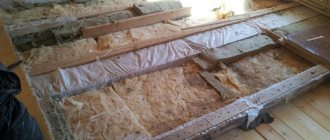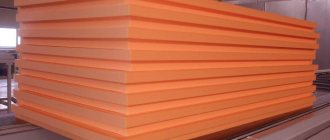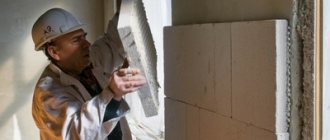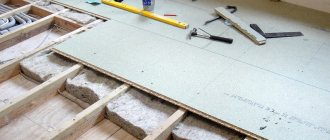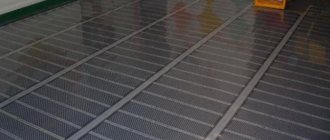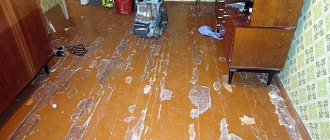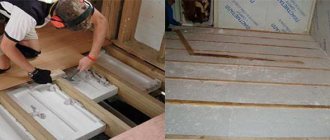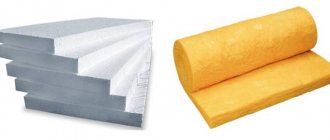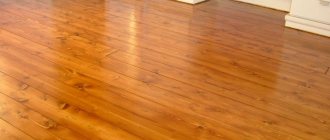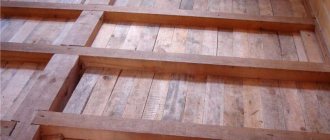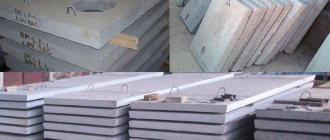Heating costs largely depend on how well the house is insulated. And special attention should be paid to the concrete floor, which is known to be the coldest. There are quite a lot of materials that can be used for thermal insulation, but in recent years extruded polystyrene foam (also called extruded) has become increasingly popular.
Insulation of concrete floors with extruded polystyrene foam
General information
Extruded polystyrene foam is a thermal insulating synthetic material created in the fifties of the last century in the USA by specialists from The Dow Chemical Company. It was then that a more modern technique of foaming a special “cocktail” of polymers during extrusion (extrusion through a die) was first used.
At first, the foaming reagents were carbon dioxide and freon. But since 1999, due to the fact that freon has a detrimental effect on the ozone layer of the planet, they began to use a freon-free method for manufacturing the material.
Extruded polystyrene foam
Technical characteristics and types of extruded polystyrene foam
| Index | Polyspen | Polyspen Standard | Polyspen 45 | Control method |
| Density, kg/m3 | 30-38 | 30-38 | 38,1-45 | 5.6 each |
| Bending strength, MPa, not less | 0,4 | 0,4 | 0,4 | 5.8 each |
| Water absorption in 24 hours, % by volume, no more | 0,4 | 0,4 | 0,4 | 5.9 each |
| Thermal conductivity at 25+-5 degrees Celsius, W/m * °C, no more | 0,028 | 0,028 | 0,030 | at 5.10 |
| Toxicity, Hcl 50, g/m3 | T2 moderately hazardous | T2 moderately hazardous | T2 moderately hazardous | at 5.11 |
| Flammability group | G-3 normal-flammable | G-4 highly flammable | G-4 highly flammable | at 5.12 |
| Flammability group | B-2 moderately flammable | B-3 flammable | B-3 flammable | at 5.13 |
| Smoke coefficient | High smoke generating ability | High smoke generating ability | High smoke generating ability | at 5.14 |
| Compressive strength at 10% linear deformation, MPa, not less | 0,2 | 0,2 | 0,3 | 5.7 each |
Ecowool
Ecowool
This material is very similar in characteristics to mineral wool, but is made from cellulose fibers, therefore it is absolutely safe for health. Just like mineral wool, ecowool is afraid of water and is easily deformed. Therefore, in most cases it is used to insulate wooden floors between floors.
Ecowool insulation
The big advantage of ecowool is that it is installed by spraying under pressure from a special pipe. Thus, the insulation can be “blown out” under the already assembled floor; for this you only need to make several small technological holes.
Spraying ecowool
The required thickness of the ecowool layer corresponds to the thickness of the mineral wool layer, all other things being equal.
Characteristics of basalt and ecowool
Basic properties of the material
Thanks to its unique characteristics, extruded polystyrene foam (EPS) can significantly reduce heat loss. Of course, if the installation was done correctly.
Video - Comparison of EPS
Among the many positive qualities of the material, it is worth highlighting the following.
- The vapor permeability index of extruded polystyrene foam is 0.013.
- Floor insulation using EPS provides reliable protection from the cold and improves the quality of waterproofing. The moisture absorption of the material is quite low, which is especially important in matters of thermal insulation, because if the insulation is wet, it simply will not be able to perform its main function.
- The material is produced in the form of slabs, which weigh quite little due to closed air capsules.
- The density of extruded polystyrene foam is high; it can withstand loads of up to 400 kg per 1 m². There are even special types of material (they can withstand even greater loads) that are used to insulate runways and roads. In short, you don’t have to worry about the floor settling after pouring the concrete screed.
- The material perfectly tolerates humidity and temperature changes (from -500ᵒC to +750ᵒC), it is resistant to microorganisms and deformation.
- Finally, it goes well with water or electric underfloor heating systems.
Important information! The cost of EPPS is on average 4,000 rubles per cubic meter.
Thermal insulation of floors with extruded polystyrene foam
Parameters for choosing insulation, what we pay attention to
When purchasing floor heating from expanded polystyrene, you should take into account indicators such as: quality and variety.
Initially, the quality of polystyrene foam boards for heated floors is determined by their appearance. The following points should be taken into account:
- Color - should be bright and uniform, which indicates compliance with the technological process. Most often sold in blue or orange. The color scheme itself does not affect the characteristics of the product.
- Smell – a strong odor is unacceptable, a slight, slight specific odor may be present.
- The shape is clear geometric, and the edges are smooth and do not crumble.
- The granules are the same size without voids.
- The surface is flat, otherwise the thermal insulation qualities will be reduced.
For your information! Experts recommend especially inspecting the place of the cut or break. If the granules are intact in this area, we can talk about their poor adhesion to each other. In a high-quality slab, when broken, the granules should also be destroyed.
Fire resistance: myths and reality
Both manufacturers and distributors of extruded polystyrene foam unanimously insist that this material has no disadvantages. But in reality this is not the case. It’s not for nothing that the use of XPS in construction is prohibited in America and most European countries, and there is more and more criticism from the media. The cause was a fire in a recently renovated building in Frankfurt, Germany. As it turned out, the house was insulated with extruded polystyrene foam and it was this heat insulator that, for unknown reasons, caught fire and led to the rapid spread of the fire.
Extruded polystyrene foam production line
It is quite obvious that in light of these events, the attitude towards XPS in many countries is ambiguous. After all, even materials that contain fire retardants are very dangerous for others in the event of a fire. Yes, fire retardants prevent the spread of fire, but during smoldering, polystyrene foam releases toxic substances that can lead to poisoning and even death.
Flammability of extruded polystyrene
However, the popularity of this thermal insulator is still growing, and it is still used to insulate buildings. Let's look at how to use it to insulate a concrete floor.
Work on mistakes
In order to correctly and efficiently organize the work, it is important to avoid the following mistakes:
- Do not ignore the line of the first floor and basement. The appearance of defects on the plaster layer may indicate incorrect installation of the plinth strip. To eliminate this flaw, it will be necessary to remove about ten centimeters of a layer of plaster along the lower edge. In addition, you will need to cut off a fragment of thermal insulation that covers this structural element. Then the rail is securely fastened and covered with a mesh for reinforcement up to the bottom edge. Fragments of the old and new mesh covering are connected, taking into account an overlap of ten centimeters. The final stage is re-plastering.
- Securely insulate extruded polystyrene from contact with the ground. Contact with the ground leads to wetting of the material and significantly reduces its performance properties. The base rail will serve as a kind of protection in such a situation. To correct such an error, you will need to remove the bottom heat-insulating layer and replace it with extruded polystyrene foam, which is less sensitive to moisture.
- It is important to consider weather conditions during installation. It is recommended to carry out work at ambient temperatures ranging from 20 to 25 degrees Celsius.
- The insulation layer should be made as thick as possible. If thin sheets are used, the floor surface will be cold.
- The building material in question is not recommended for use for thermal insulation of wooden residential buildings. The reason lies in the fact that eps prevents the effective removal of moisture from wooden surfaces, as a result of which the process of their deterioration is activated. Therefore, take note that it is necessary to insulate floors in wooden houses using other types of materials for thermal insulation.
Insulation of concrete floors with extruded polystyrene foam
Insulation of a concrete floor with polystyrene foam
Often the heat insulator is laid on a bare concrete base and filled with screed. Of course, you can put wooden logs on the base (we'll talk about this a little later), but in this case all the advantages of concrete are lost. Therefore, everyone must decide for themselves which option suits them best.
Important information! Below is only a general diagram of the “pie”, but it may vary depending on the level of humidity, the presence of a basement (if we are talking about a private house or the first floor of a multi-story building), the screed used, etc.
Now - directly to the workflow.
Equipment and consumables
Before you begin installation, you need to prepare everything you need. The work will require the following materials:
- Eps boards;
- cement, sand;
- reinforcing mesh;
- liquid Nails;
- waterproofing primer mixture;
- polyethylene film;
- self-leveling floor (for initial and finishing processing).
Important information! EPS slabs are lightweight, so the floor will not be subject to additional load. And the use of special fire retardants makes the material non-flammable (but do not forget about toxic smoldering).
Eps boards
We also add that the material is easy to install, because it can be cut with a regular knife. As for the equipment, it should be as follows:
- perforator;
- sealant gun;
- electric drill;
- a screwdriver (although a regular screwdriver will do);
- pencil;
- level;
- roulette;
- knives.
After preliminary preparations, you can begin preparing the base.
Stage one. Floor preparation
Step 1. First, the old floor covering is dismantled (down to bare concrete).
The first step towards insulating the floor will be dismantling the old covering
Step 2. All debris is removed, the surface is cleaned of dust and dirt.
Preliminary preparation
Step 3. The floor is treated with a primer mixture in accordance with the manufacturer's instructions.
Primer screed
Step 4. Once the primer has dried, the floor is checked for differences using a building level. If differences of more than 0.5 cm are detected, they are filled with a leveling mixture.
Checking the levelness of the base
Step 5. After this, a finishing self-leveling floor 3-5 cm thick is poured (as an option, a geotextile fabric with a density of at least 300 g/m² is laid; both methods will allow you to effectively level out minor unevenness).
Important information! Despite the fact that initial setting requires about 6-10 hours, further work can be carried out at least 48 hours after pouring.
Stage two. Laying extruded polystyrene foam
Step 1. First, a damper tape is glued along the perimeter of the room at the bottom of the walls, which is necessary to compensate for thermal expansion.
Attaching the edge tape
Step 2. The surface is covered with a waterproofing layer - you can use polyethylene film for this. Waterproofing is necessary to prevent the penetration and condensation of moisture, otherwise the insulation may lose its properties. The film is laid with an overlap of 10-15 cm and extends onto the walls to a height corresponding to the thickness of the entire “pie”.
Step 3. Next, polystyrene foam is laid (it should be dense - about 100 microns). Laying is done manually; there are special mounting grooves along the edges of the slabs, so there will be no difficulties with this. The slabs are installed end-to-end, no additional fastening is required. If necessary, the material is cut into the required pieces using a regular knife.
Laying extruded polystyrene foam
Step 4. Upon completion of installation, the insulation is covered with a layer of vapor barrier film. The canvases are laid with the same overlap of 10-15 cm and with a similar release on the walls. All joints are sealed with mounting tape.
Important information! Insulation sheets should be installed as tightly as possible, otherwise the technology will not be effective enough. If cracks have formed, they should be filled with polyurethane foam.
Stage three. Screed
Step 1. A reinforcing mesh is laid on top of the vapor barrier film.
Reinforcement
Step 2. The surface is filled with a concrete screed 3-5 cm thick. The solution can be prepared yourself (preparation - sand + cement in a ratio of 3: 1) or purchased ready-made.
Filling the screed
At this point, the installation work is almost complete. Laying the floor covering can only be carried out after the concrete has completely dried, otherwise the technological strength of the covering is not guaranteed.
Grouting screed
By the way, for structural rigidity, you can lay OSB boards, and this can be done directly on top of the screed if the floor surface is level.
Video - Installation of OSB boards on a concrete base
Granular foam
Unfortunately, today this technology has not yet found widespread use in our country. The reason is that for the production of a solution based on granular foam, special closed units of foreign production are required. Not all construction companies have such equipment, not to mention individual developers or small construction companies.
Polystyrene foam in granules
What are the advantages of this technology?
- Minimum cost. If you calculate the price of all construction work and materials used when laying pressed and granular foam, then the cost of the latter is at least 50% lower.
- Absolutely harmless. The granular foam is covered on all sides with a cement-sand mortar, which completely eliminates the entry of harmful chemical fumes into the air.
- Non-flammability. This technology for floor insulation is approved by fire authorities for use even in very critical buildings.
- Simplicity of technology. All work can be completed within one day, there is no need to waste time on preparatory operations, the construction technology consists only of pouring. There is no need to level the base, install beacons, rub the surface, etc. These operations are performed automatically during pouring.
Polytherm: foam granules
Video - Foam granules
To prepare the solution, one part of granulated foam should be given one part of cement-sand mortar. If there is a need to increase the load-bearing capacity of the screed, then the amount of cement increases. In terms of thermal insulation qualities, such a screed fully satisfies most requirements. In addition, it is possible to install any type of flooring on it in the future, including heated ones.
Screed with granular foam
Insulation of concrete floors using joists
This method of thermal insulation involves laying insulation between the joists, which are installed on a concrete base. The algorithm of actions is given below.
Step 1. First, the old floor covering is dismantled, the surface is cleaned of debris and dirt. Then the base is leveled in the same way as described in the previous paragraph of the article.
Step 2. Waterproofing material is laid (polyethylene film is suitable) with a minimum overlap of 10 cm. All joints are sealed with mounting tape.
Step 3. Next, the logs are installed. The pitch depends on the width of the extruded polystyrene foam sheets, and the height depends on the thickness (5 cm, 10 cm or 15 cm). To fix it on the supporting plate, holes are made in the logs, then the guides are installed according to the previously made marks and secured with driven dowels.
Step 4. Insulation boards are laid, a regular knife is used for cutting.
Insulation of concrete floors using joists
Photo of how to properly lay insulation and joists on the floor
Step 5. A vapor barrier material is attached to the joists on top of the insulation.
Step 6. Next, a durable material is laid (often OSB boards), on top of which the flooring will be laid. The plates are fastened with self-tapping screws in increments of 30 cm; between them (the plates) you need to leave a small gap (about 3 mm) for temperature and humidity compensation. This installation method is called “floating” and it provides for a gap between the walls and slabs of at least 1.2 cm.
An example of attaching a floorboard over insulation
Important information! For greater reliability of fastening, the slabs can be glued to the guides using special wood glue.
All that remains is to lay the flooring.
Video - Thermal insulation with polystyrene foam on joists
Where installation is allowed
Expanded polystyrene is recommended as insulation where an increase in the load on the load-bearing floors of the room is unacceptable, and in cases with low ceilings. During construction work, polystyrene foam is used to insulate:
- water pipeline;
- roofing;
- floor;
- door and window slopes;
- walls.
For example, thermal insulation of pipe materials with polystyrene foam for water-heated floors is considered financially justified due to its properties.
In addition, the use of block polystyrene foam makes it possible, in case of problems, to gain access to the pipeline by removing a separate section of the coating. For the same reason, the product is often installed when constructing warm electric floors.
Adding polystyrene chips to concrete
To give the concrete layer additional protective characteristics, granules of extruded polystyrene foam can be added to the solution (the latter can be purchased for about 1000-1800 rubles per cubic meter). This is done as follows.
Foam balls for concrete can be purchased pre-packaged
Step 1. A little water is poured into the prepared container, then dry cement is poured into it. All this is mixed with a mixer attachment until the consistency of thick sour cream.
Mixing the solution with polystyrene balls
Step 2. During the mixing process, polystyrene foam granules are added. The proportions of concrete can be very different - both 1:3 and 1:6.
The more granules there are, the more efficiently the floor will retain heat. But there is also a downside to the coin - this will deteriorate the strength, and the surface will begin to crumble under load. In short, the required ratio of polystyrene foam depends directly on how hard the floor covering should be.
Foam chips (expanded polystyrene granules)
Expanded clay
Expanded clay
Expanded clay is a popular thermal insulation material used in wooden floors and floors with dry screed based on gypsum fiber board. In the latter case, in addition to thermal insulation, it is also a leveling material.
Expanded clay is one of the cheapest materials for thermal insulation; it does not burn, is safe for health and is lightweight. At the same time, it easily absorbs water, which reduces its thermal insulation properties and significantly increases its weight. Therefore, the use of expanded clay requires reliable waterproofing. Another disadvantage of expanded clay is that when working with it, a large amount of dust rises into the air.
Expanded clay as thermal insulation
In terms of thermal insulation properties, expanded clay is inferior to most synthetic materials, so it requires backfilling with a thicker layer, which reduces the height of the ceilings in the room.
Using expanded clay for insulation. The photo shows expanded clay being poured with lean concrete
For effective thermal insulation of the first floors of buildings from the ground, the expanded clay layer must be at least 400 mm when using wooden floors and 300 mm when using concrete floors.
Between the floors of private houses, at least 200 mm of expanded clay should be poured into the floors for wooden floors and 150 mm for concrete floors. In apartment buildings, a layer of expanded clay of 50-80 mm is sufficient.
| Indicators | 10-20 mm | 5-10 mm | 0-5 mm |
| Bulk density, kg/m3 | 280-370 | 300-400 | 500-700 |
| Crushing strength, N/mm2 (MPa) | 1-1,8 | 1,2-2 | 3-4 |
| Grading, % | 4 | 8 | 0 |
| Frost resistance 20 cycles, gravel weight loss, % | 0,4-2 | 0,2-1,2 | not regulated |
| Percentage of crushed particles, % | 3-10 | 3-10 | No |
| Thermal conductivity, W/m*K | 0,0912 | 0,0912 | 0,1099 |
| Water absorption, mm | 250 | 250 | 290 |
| Specific effective activity of natural radionuclides, Bq/kg | 270 | 270 | 290 |
If there is no basement
*
Here all processes are carried out from the premises.
- The so-called cranial bars are packed along the joists along their lower edges.
- The logs are laid across them and boards, plywood, OSB, chipboard, etc. are attached.
- A waterproofing membrane is laid along the joists and formed niches so that it exactly follows the contours of the assembled joist structure. Pay attention to the photo below. This is how waterproofing should be installed.
Waterproofing a wooden floor
All other operations are carried out in exactly the same way as in the previous case.
